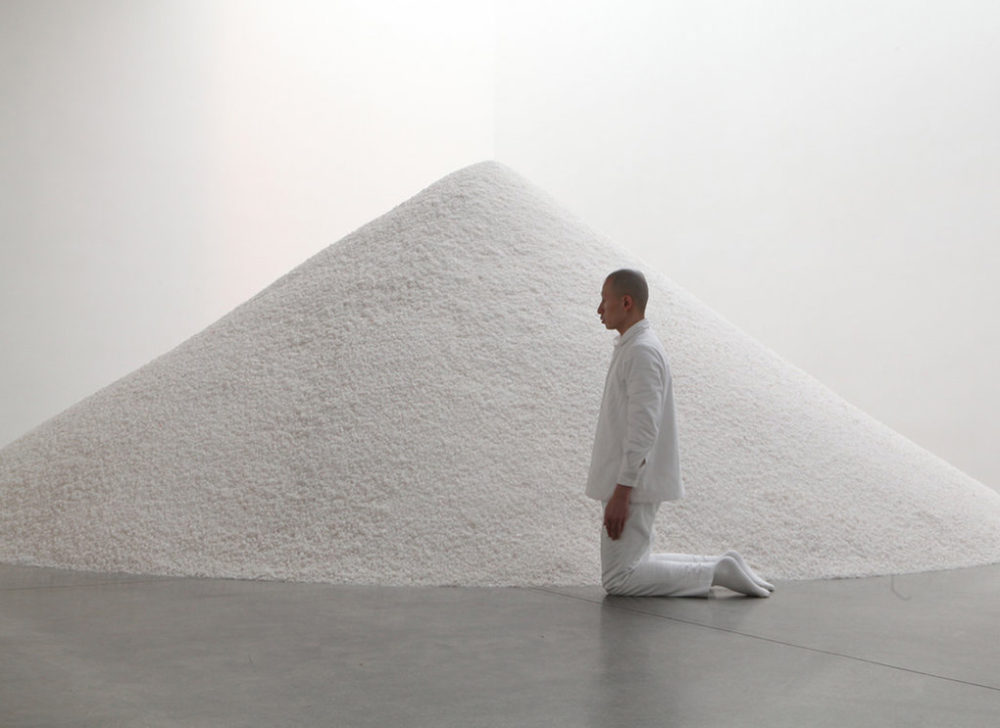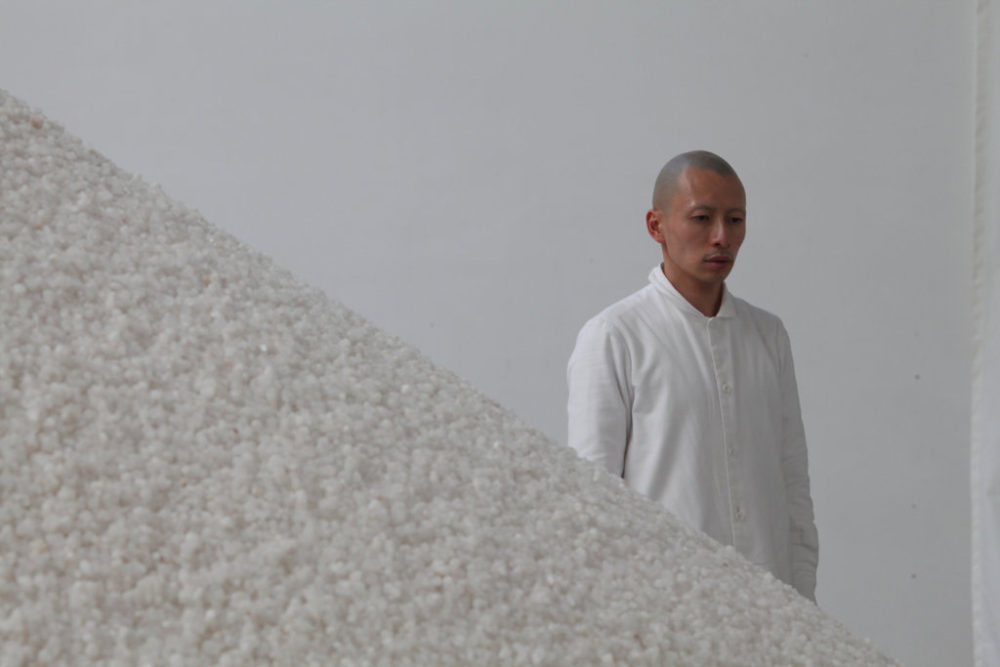
- Source: The New York Times
- Author: Roberta Smith
- Date: March 10, 2011
- Format: PRINT AND DIGITAL
Crawling for Peace in a Not-Quite Salt Mine
Exhibition Review

Terence Koh circles a pile of salt on his knees in “nothingtoodoo,” at the Mary Boone Gallery. Credit Chester Higgins Jr./The New York Times
Terence Koh is an artist of many moods, most of them flamboyant or aggressive. He began his career with a Web site and zine, asianpunkboy.com, and quickly morphed into an art-world darling, known for swanning around in white furs and generally acting out. He once described himself as “the Naomi Campbell of the art world.”
In his art, though, Mr. Koh, who was born in Beijing in 1977 and grew up in Canada, practices a kind of gleeful asceticism, one that mixes parody and spirituality while riffing on a long line of 20th-century purist-provocateurs starting with the Dadaists. He specializes in white-on-white installations and paintings involving white chocolate, powdered sugar or his semen. Sculptures have included clumps of his excrement covered in gold leaf. For a project show at the Whitney Museum he simply set a blinding light on a tripod in an otherwise empty gallery, creating a work of art that was painful if not impossible to look at.
Among my favorite Koh works is a frenetic, hilariously satirical slide lecture conducted in an invented language that links ancient art, conceptually inclined subversives (including himself) and gay pornography. Last season Mr. Koh delivered it wearing his signature white suit at the National Arts Club and again at MoMA PS 1; there’s a video of him presenting it on another occasion in platform boots, black dress and geisha-style hair and makeup.
With “nothingtoodoo,” his first solo show at the Mary Boone Gallery, Mr. Koh gives his ascetic side full reign, to disconcerting effect. He is performing a kind of abject penance that is hard to dismiss, even if you may initially want to; it is too quiet, unsettling and self-effacing. It involves a fair amount of physical discomfort, if not downright suffering, and in its own way it too is hard to look at.
The show consists of Mr. Koh, dressed in white pajamalike clothes, slowly circling a beautiful cone-shaped pile of rocky solar salt — 8 feet high and 24 feet across — on his knees. Not his hands and knees, his knees. Staring straight ahead, his upper body motionless, he circumnavigates the salt almost nonstop during the gallery’s public hours — eight hours a day, five days a week — and has been doing so for four weeks. Occasionally he lies prostrate on the floor; the gallery says he started using kneepads after the first week.

Terence Koh circling a cone of salt, as he does during gallery hours, eight hours a day. Credit Chester Higgins Jr./The New York Times
This is performance art reduced to a bare and relentless rite in a space that has been stripped down to a kind of temple. (Its regal proportions help.) Most furniture has been removed from the reception area; a wall of shelves usually arrayed with catalogs is empty; skylights provide the only illumination. The monumental mound of salt — a preservative and curative that can also inflame open wounds — conjures altars and offerings, as well as pain and healing.
Judging by a cryptic artist’s statement that begins “peace iz non-violence/peace iz everywhere/peace iz now,” Mr. Koh is walking on his knees for peace. Perhaps he means world peace, for which John Lennon and Yoko Ono went, far more comfortably, to bed. Perhaps he means inner peace, of which, it could be argued, he could use some. Maybe the work is an extended apology for past bad-boy behavior.
Mr. Koh’s work often refers to other art with a mix of reverence and irreverence. His use of simple forms, monochromes and gold leaf, for example, brings to mind artists like Yves Klein, Piero Manzoni and James Lee Byars. A 24-foot-long urinal that he contributed to a 2009 group show at Boone paid homage to Marcel Duchamp and Robert Gober while also evoking the communal exhibitionism of certain gay bars.
Now Mr. Koh also seems to be taking on the endurance artworks of Marina Abramovic and Tehching Hsieh, and especially some of Chris Burden’s early, so-called danger pieces. As an ordeal “nothingtoodoo” could be ranked somewhere between Mr. Burden’s 1971 “Five Day Locker Piece” — he locked himself in an art-school locker for five days — and the 1974 work “Trans-fixed,” in which he was briefly crucified (hands only) on the back of a Volkswagen. And while this may be a bit of a stretch, there is a way that Mr. Koh, on his knees, becomes a diminutive, uncannily childlike figure reminiscent of the puppet or doll sculptures of Pierre Huyghe and especially Maurizio Cattelan.
There’s a “for real” quality to “nothingtoodoo” that performance art achieves only rarely. Mr. Koh’s painful circling thwarts many of the expectations associated with the genre. It is not especially sensational or funny or entertaining. It doesn’t involve bravura skill or derring-do. There is little to watch, in either a visual or voyeuristic sense — nothing to do — although the salt, the unusually austere gallery and Mr. Koh’s self-contained concentration definitely create their own atmosphere.
The piece doesn’t challenge viewers directly, either, or invite them to line up and participate, but there has been some unscripted joining in. The gallery said that before the exhibition began, Mr. Koh — who took an oath of silence for the work’s duration — had said all reactions to it would be tolerated as long as they did not disturb or threaten him. On the show’s opening day, and also last Saturday, a slight Asian man in a dark suit with small flesh-colored prosthetic devil’s horns on his shaved head — quite believable as a Koh doppelgänger — followed Mr. Koh on his knees for a while. Most observers, me included, assumed it was part of the piece. Maybe Mr. Koh is counting on “nothingtoodoo” to create a protective force field that discourages such activity; if so, it’s mostly succeeding.
In his statement Mr. Koh refers to “a perfect mountain of salt” at the show’s beginning that will be a “a perfect field of salt” by its end. According to the gallery Mr. Koh initially intended to level the pile of salt with either his hands or his knees as the work progressed. This part of the plan is not being executed and does not seem humanly possible. I already wish Mr. Koh — whose movement seems increasingly tentative and whose prostrations are becoming more frequent — would stop while he still has knee joints.
By being tied to the higher ideal of peace, his performance resonates, even under these rarefied circumstances, with a history of principled abstinence and self-inflicted pain. Is it really art? It definitely emphasizes the philosophical nature of Mr. Koh’s work, previously conducted with a fair amount of camp and posturing. All along he has raised questions about the nature of art, the role of the artist (and the artistic persona) and the condition of otherness. Here he may have “othered” himself right out of the art world into a larger sphere of symbolic action.
The result is a strange and affecting dissonance. Destroying your knees for peace — whether world or inner — may not be the ultimate sacrifice, but it definitely makes a point.

